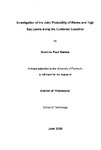Investigation of the Joint Probability of Waves and High Sea Levels along the Cumbrian Coastline
| dc.contributor.author | Hames, Dominic Paul | |
| dc.contributor.other | Faculty of Science and Engineering | en_US |
| dc.date.accessioned | 2013-10-23T11:40:57Z | |
| dc.date.available | 2013-10-23T11:40:57Z | |
| dc.date.issued | 2006 | |
| dc.identifier | NOT AVAILABLE | en_US |
| dc.identifier.uri | http://hdl.handle.net/10026.1/2324 | |
| dc.description.abstract |
The use of joint probability techniques for wave heights and sea levels to estimate potential damage and overtopping of flood defences is of vital importance in coastal defence work. Without the use of joint probability techniques, confidence in the appropriate design conditions are poor, and defences could be built to an incorrect design standard. This has the potential effect of a coastal or estuary scheme being under-designed, and therefore not suitable for the purpose it was built for or over-designed, and therefore built to a much greater cost than required. With no research having considered the joint probability relationship between waves and high sea levels at nearshore locations, this study has therefore been defined to investigate this relationship spatially for an approximate 100km length of coastline for different nearshore beach levels in Cumbria. This should improve the understanding of the joint probability relationship nearshore, and enable this relationship to be reliably estimated for other coastlines where appropriate data is not available. To investigate this relationship, 13.2 years of coincident waves and sea levels have been determined nearshore at regular 400m centres, and at 5 regularly spaced beach levels from 2m above and below Ordnance Datum. The wave transformation model REFDIF has been used to determine nearshore wave heights, using data from two deep water Met Office prediction points. Sea levels have been determined using recorded data from all known tide gauges and tide log books. From an analysis of the results, clear relationships appear to exist over lengths of coastlines that have similar exposure conditions. Given the joint probability relationship at one location, the joint probability relationship at the second can be reliably estimated based on estimates of the ex1reme wave height and sea level at the second. Joint probability curves were noted to show a consistent shape within bays, as well as at headlands, steep beaches and for coastlines that had a change in direction away from the predominant wave direction. As beach levels increased, the joint probability curves became increasingly generic, and it was noted that at the most ex1reme sea levels return period wave heights generally increased for higher beach levels. | en_US |
| dc.language.iso | en | en_US |
| dc.publisher | University of Plymouth | en_US |
| dc.title | Investigation of the Joint Probability of Waves and High Sea Levels along the Cumbrian Coastline | en_US |
| dc.type | Thesis | |
| dc.identifier.doi | http://dx.doi.org/10.24382/3660 |
Files in this item
This item appears in the following Collection(s)
-
01 Research Theses Main Collection
Research Theses Main


